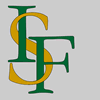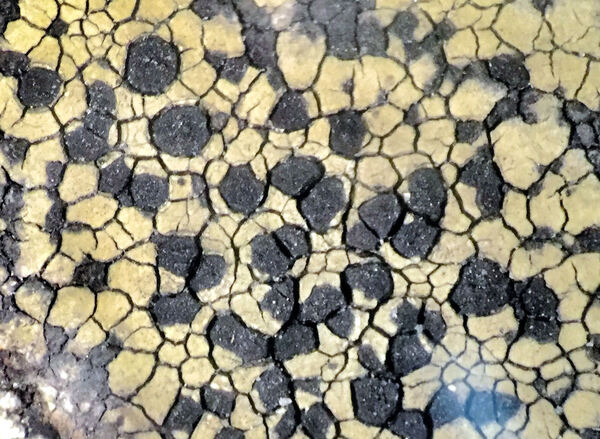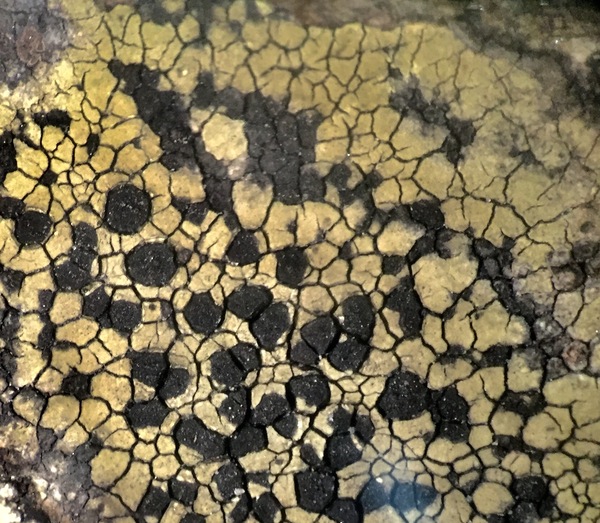Rhizocarpon geographicum subsp. prospectans (Räsänen) D. Hawksw. & Sowter
Trans. Leicester Lit. Phil. Soc., 63: 58, 1969. Basionym: Rhizocarpon prospectans Räsänen - Ann. Bot. Soc. Zool.-Bot. Fenn. Vanamo, 19: 8, 1944.
Synonyms: Rhizocarpon tinei subsp. prospectans (Räsänen) Runemark
Distribution: N - Lomb.
Description: Thallus crustose, episubstratic, bright yellow-green, areolate, forming up to 10 cm wide patches delimited by a black prothallus, the areoles more or less angular, 0.4-3 mm wide, 0.2-0.4 mm thick, irregularly subdivided by cracks into 0.1-0.9 mm wide units, contiguous, flat, smooth, epruinose, sometimes forming a crescent-shaped collar around the apothecia. Cortex without a distinct structure, with abundant small crystals insoluble in K; medulla white, I+ blue. Apothecia frequent, lecideine, arising between the areoles and often surrounded by collar-like areoles, rounded, 0.4-1.5 mm across, with a black, weakly concave to weakly convex, epruinose disc and a very thin, often indistinct, black proper margin. Proper exciple pale brown to brownish red; epithecium brown, K-; hymenium 110-160 µm high, colourless to greenish, K/I+ blue, K+ greenish; paraphysoids strongly coherent, richly branched and anastomosing, the apical cells sometimes slightly capitate; hypothecium dark brown, K-. Asci 8-spored, clavate, fissitunicate, with a well-developed tholus that is K/I- in lower part and K/I+ blue near the apex, lacking an ocular chamber, Rhizocarpon-type. Ascospores submuriform, with (6-)8-14(-16) cells visible in optical view, soon becoming dark green to brown, ellipsoid, (22-)32-37 x 13-15 µm, halonate at least when young. Photobiont chlorococcoid. Spot tests: medulla K-, C-, KC-, P-. Chemistry: rhizocarpic acid.Note: on exposed surfaces of base-rich siliceous rocks. A western lichen in Europe, which needs further study.
Growth form: Crustose
Substrata: rocks
Photobiont: green algae other than Trentepohlia
Reproductive strategy: mainly sexual
Most common in areas with a humid-warm climate (e.g. most of Tyrrenian Italy)
Poorly known taxon in need of further study
Commonnes-rarity: (info)
Alpine belt: absent
Subalpine belt: extremely rare
Oromediterranean belt: absent
Montane belt: very rare
Submediterranean belt: absent
Padanian area: absent
Humid submediterranean belt: absent
Humid mediterranean belt: absent
Dry mediterranean belt: absent

Predictive model
Growth form: Crustose
Substrata: rocks
Photobiont: green algae other than Trentepohlia
Reproductive strategy: mainly sexual
Most common in areas with a humid-warm climate (e.g. most of Tyrrenian Italy)
Poorly known taxon in need of further study
Commonnes-rarity: (info)
Alpine belt: absent
Subalpine belt: extremely rare
Oromediterranean belt: absent
Montane belt: very rare
Submediterranean belt: absent
Padanian area: absent
Humid submediterranean belt: absent
Humid mediterranean belt: absent
Dry mediterranean belt: absent

Predictive model
 INDEX FUNGORUM
INDEX FUNGORUM
 GBIF
GBIF





